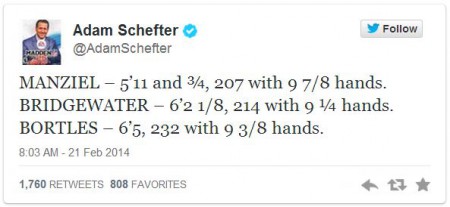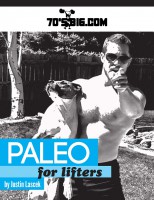Adam Schefter works for ESPN and is an NFL reporter who gets all the “insider” information. The above tweet is talking about the top three quarterbacks that will be going into the NFL draft this year. These stats are gleaned from the NFL Combine, which allows the NFL personnel to evaluate the talent coming from collegiate sports to the NFL. It’s a lot of mental and physical testing to try and project how well these athletes will do in professional football, yet it is often incomplete because physical stature and prowess do not always make the best football player, though it helps.
I was listening to Mike and Mike on ESPN radio this morning, and they were talking with various experts on the size of these quarterbacks, particularly Manziel and Bridgewater. The important stats for quarterbacks, from an anthropometry perspective, are height, weight, and hand size. The hand thing is apparently a good projector of success (i.e. it’s easier to hold onto a football in adverse weather), but let’s ignore that. Height is also very important — seeing over the large lineman to throw a pass is important — but we’ll ignore that too. How much a guy weighs and fills out his frame is important because football is a rough, collision-based sport, and frail guys will not have durability. Especially when there are mastodons who weigh anywhere from 250 to 350 pounds wanting to crush your soul.
The experts point out that two of the above quarterbacks weigh 207 and 214. As a “lifting and athletic population”, we know that these guys aren’t heavy. Yet we also know that it’s actually kind of simple to add mass on to a guy, especially when their frame has room to fill out (as both of those quarterbacks do).
What I find baffling is how difficult the experts think gaining weight is. And I’m not even just talking about gaining weight for the sake of gaining it, like in Starting Strength-style linear progression. I’m talking about putting a focus on retaining athleticism, agility, and speed yet increasing lean body mass. Most rookie mini-camps don’t start until the end of May. Training camp starts in July. The season actually starts in September. How long was your linear progression? I got some pretty solid fucking progress in 8 weeks by moving my three-sets-of-five from 325 to 445 while increasing my body weight from 195 to 215 (in 2009).
If the experts think it’s difficult to put five, ten, or even fifteen pounds on a guy in three to six months, then either the strength and conditioning is really shitty, there’s no athlete compliance, or they don’t even try. I’m no expert in the realm of NFL strength and conditioning, and maybe we should get John Welbourn’s thoughts, but it sounds pretty stupid to see a 21 year old’s body and think that it can’t be improved. I’ve done it over and over with athletes, so why can’t they?
Edit: I forgot to mention what I would do for a guy that needed to retain athleticism but increase size. I’d have him lift three days a week in conjunction with his agility, speed, and/or skill sessions. He’d squat, press, row, and do pulling movements that wouldn’t interfere much with his other training (i.e. stuff like power cleans, RDL’s, and lighter deadlifts instead of trying to push his deadlift up). A quarterback would be doing weighted pull-ups and chin-ups, possibly some barbell pullovers. I’d throw a Paleo for Lifters diet at him, which would be a quality, clean diet of meat, potatoes, fruits, veggies, and good fats with a little bit of protein powder in quantities that would help him grow. It wouldn’t be all that hard for kids that are described as “not very thick” or having a “slight build”.



Please excuse for off topic – are we still Q/Aing please?
I have a main lift each day – Press, squat, bench. Then I do accessories, usually one or two BB/isolationey things – curls, skull crushers, pec flyes, half rows, RDL, that sort of thing. I’m only training to get bigger and more jackular, but I like increasing my 1rms too.
Should I do assistance exercises which use muscle groups from the main lift (so squat, RDL. Bench, skull crush, etc etc) and shred each movement’s main groups and stay fresh for the next day OR should I do groups which weren’t really involved in the main lift (so bench, RDL. Squat, curl, that sort of thing) at the expense of possibly not being fresh the next day?
Wait for Justin, his opinion is worht 10 cents to my one, but any time I do accesories when I’ll be liftng the next day, I chose them such that they do not work the muscle groups that I’ll be working the next day very hard. This comes from the same logic of doing the heavy, compound lifts first then curls for the girls after during the same workout. Being fresh for your compound lifts is the priority over any accesory.
Now that’s not to say I can’t do chins the day before rows or thrusters the day before squatting. I just need program them light enough so that their recovery will be near complete by my next compound movement that they could affect. Typically for me this is typically as a metcon using low weight, high reps, and low rest times. If you’re using the accessories to try to add mass or strengt, you’re likely hitting intensities and volumes that aren’t really completely or near completely recoverable from in 24 hours unless you’re pretty early in your lifting.
Welbourn’s interview with Rip. He talks all about S&C in the NFL. He said when he was with the Pats, they had platforms, Eleiko bars an weights and nobody touched them. He said to the S&C coach that he wanted to Squat one day and the coach said:
“Really? Haven’t seen anyone use that lately.”
That 4 part interview opens a lot of eyes when it comes to “S&C coaches” at a professional level.
If I ever got enough money so I could take care of my family and go back to school at the same time, I’d get a Kinesiology or PT degree and focus my coursework and interships toward getting into a career doing strength training for high level athletes, whether it be college or professional. I wish every day I had found my love for strength training before I graduated.
The big 3 are always important (bench, curls, hammer curls), however running is a great way to cut muscle while building a strong core and accessory muscles. Running is often ignored bc of its skinny, frail guy image but is a huge component of athleticism.
Meetch,
These s&c coaches must keep their athletes healthy and injury free in the weight room. Yes, they are trying to get them to perform better on the field but they aren’t paid to squat 1RMs.
What does a Squat 1RM have to do with using squats in an effective S/C program?
I am a long-suffering Redskins fan and few things are more demoralizing than watching the team lose again and again, year after year, but one of those things is this video of RG3’s SWEET WORKOUTS! http://www.youtube.com/watch?v=J9MIeb8X8SQ
—not a single full ROM rep. My favorite part is the trainer watching his 1/4 pull ups saying “perfect.” Haha
My god, that was horrible. You expect that sort of shit from gym bros, not a professional athlete in a power sport.
I assume that these guys had S&C coaches when they played college ball? Maybe the assumption is that they’ve put on as much mass as they are going to in college, and it will only be minor gains from here on out. Given the height and weight they report that doesn’t seem likely though.
If 70sBig is one of the best advocates for lifting weights to be strong and healthy, this might be the worst spokesperson for weightlifting: http://abc6onyourside.com/shared/news/features/good-day/stories/wsyx_sunday-holly-mangold-teaches-adam-weightlift-6509.shtml
Why lift weights? “the best thing is I don’t have to run”
Is this safe? “don’t worry, you won’t get hurt if you do it awesome.”
What does it take to be good “you have to lift a lot.”
Not the best way to convert a skeptical public.
Justin, the cover of Paleo for Lifters makes it look like you’re emphatically lecturing the reader on how catching and eating canines falls into the program. I know this isn’t the case, but maybe it could be used as inspiration for the next cover… Push pressing a pig, maybe?
Pingback: Friday 2-28-14 » CrossFit Addiction - Kennesaw CrossFit Addiction – Kennesaw